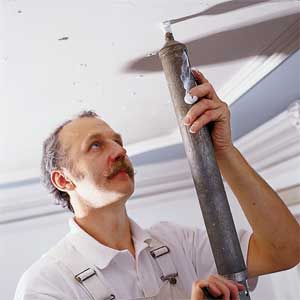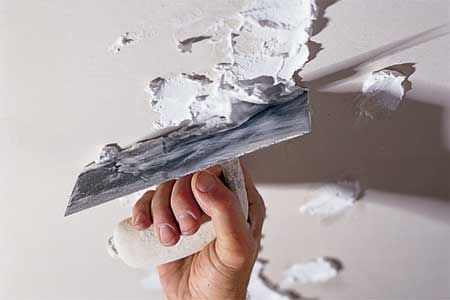
Lime plasters have been used in construction for thousands of years
everywhere from Japan to Europe. When the Charlestown house was
built in 1865, plasterers used lime plaster. Lime plasters are ideal candidates for repairs, because they crystallize over a long period of time, are flexible, and resist water damage. In short, with maintenance, lime plaster will not only last forever but will actually get better with age.
While old house plaster problems are unique to each historic building,
with a few basic tools and materials and an appreciation of history,
solutions easily present themselves. The Charlestown House had different
basic problems: a steady increase in car and truck vibration on nearby
streets, peeling paint, and water damage.
The second-floor living room suffered from its proximity to a main
street and modern traffic. Cracks radiated from the corners of the
ceiling toward the center medallion, thanks to the movement of the
outside wall.
To determine if the plaster was still attached to the lath, I drilled
several holes and judged the distance between the two. In this case,
although cattle hair kept the plaster from falling, it no longer adhered
to the lath. So the first step of my repair was reattaching the
plaster. To do this, I injected an adhesive under pressure through the
holes I drilled for evaluation, and clamped the area with screws and
washers. This adhesive established a wide, flexible bond between the
plaster and the lath that allowed movement, vibration absorption and
preservation of the historic plaster. When the adhesive was set, I
removed the clamping washers, raked out all cracks and holes and filled
them with a soft mixture of lime and gypsum so they were flush with the
surrounding plaster.
Away from the main street, the dining room’s plaster ceiling suffered
less from vibration than from peeling paint. Originally covered in
calcimine, a water-soluble paint that was frequently reapplied, the
ceiling was eventually covered with modern paint. Over the years, the
different paints began to expand and contract at different rates,
opening up cracks in the paint that allowed water vapor to re-hydrate
the calcimine and release its bond with the plaster, causing the paint
to peel. The good news was that a few passes with a wallpaper steamer
removed the rest of the paint without harming the plaster below. The
plaster was then washed, allowed to dry and painted. The main rooms’
ceilings suffered from this malady and benefited from this simple cure.
The house’s medallions suffered from the same problem as its ceilings. The
medallion in the second-floor living room, marked by a fruit-and-vegetable motif, was moved to the dining room and a new medallion,
suitably Second Empire in style, was installed there. To duplicate the
original medallion, I removed the paint, made repairs, made a mold and
cast a new medallion. On the first floor I used this same treatment on
the three medallions to uncover detail lost to paint buildup and damage
incurred when the house switched from gas to electric light. Once
repaired, the ornaments were reattached with adhesive plaster as they
had been originally.
The house’s cornice work was sound but suffered from water damage and
holes left behind by old steam heating pipes. In addition, layout
changes required new cornices to match the old. For these repairs,
in-kind replacements were the order of the day. Holes and cracks were raked
out and filled using a mixture of lime putty and gypsum with a higher
level of gypsum than in general plaster repairs. As the plaster started
to set, I developed the cornice profile with a mitre rod.
The number one at-risk historic material in this country is interior
plaster. Historic plasters can be fixed and preserved to be part of a
cost-effective restoration process. Modern alternatives do not measure
up in the long run to maintaining historic plasters. Sadly in the 20th
century, maintenance was often considered an unfortunate side effect of
house custodianship. In this new century people are now reaching back to
preserve our collective architectural history.

